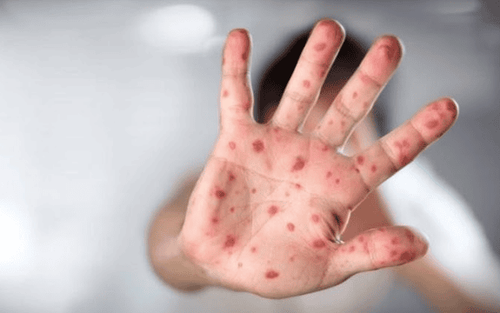The article was consulted with Dr. Lê Thu Phương - Pediatrician - Neonatologist - Department of Pediatrics - Neonatology - Vinmec Hai Phong International General Hospital.
In Vietnam, according to reports, the number of children diagnosed with Hand, Foot, and Mouth Disease has increased 5 to 6 times compared to the same period last year. This is an infectious disease with a rapid spread rate, easily becoming an epidemic. If not detected early and treated promptly, the disease will pose a danger to the patient's health
1. What is Hand, Foot, and Mouth Disease in Children?
The main cause of Hand, Foot, and Mouth Disease is primarily due to a group of enteroviruses, most commonly Coxsackie A16 and Enterovirus type 71, usually occurring in young children under 10 years old, especially in the age group from 1 to 3. When first showing signs of Hand, Foot, and Mouth Disease, children often have a mild fever, sore throat, loss of appetite, and drooling. The disease spreads quickly through fluids, saliva, nasal secretions, feces, etc., of infected children. About 24 hours after the viruses enter the body through the mucous membranes or intestines into the lymphatic system, they cause skin and mucous membrane lesions on the hands, feet, mouth, anus, etc.

Coxsackievirus A16 causes a mild form of the disease, which usually resolves on its own within 7 to 10 days without treatment. Meanwhile, Enterovirus 71 (EV71) causes a severe form of the disease with many dangerous complications such as meningitis, encephalitis, pneumonia, myocarditis, and even death.

In addition to Coxsackie A16 and Enterovirus type 71, some other group A viruses such as Coxsackie A4-A7, A9, A10, or group B Coxsackie viruses (B1-B3, and B5) can also cause the disease.
The virus causing Hand, Foot, and Mouth Disease can spread very quickly through the mouth, through secretions from the nose, mouth, feces, or saliva of the patient. Accordingly, when the viruses enter the body through the oral or intestinal mucosa into the lymphatic system after about 24 hours, they cause skin and mucous membrane lesions on the mouth, hands, feet, anus, etc.
2. Signs of Hand, Foot, and Mouth Disease in Children
Common signs in children with Hand, Foot, and Mouth Disease include:
- Mild fever
- Red spots and blisters on the skin, especially on the palms and soles
- Small ulcers around the mouth and inside the mouth cause pain, crying, and loss of appetite
Accordingly, the red spots, blisters, and mouth ulcers in children are usually not too large and have an oval shape. Hand, foot, and mouth disease usually incubates for about 3 to 6 days.
In the initial stage, patients with Hand, Foot, and Mouth Disease often show easily recognizable signs such as mild fever (37.5°C - 38°C) or high fever (38°C - 39°C), loss of appetite, fatigue, sore throat, diarrhea, drooling, and painful mouth and teeth lesions.
After 1 to 2 days of onset, the disease progresses to the full-blown stage, and children begin to show typical symptoms of Hand, Foot, and Mouth Disease, such as: the appearance of grayish water blisters, 2 to 10mm in size, oval-shaped on the hands, feet, mouth, and buttocks.

In addition, depending on the individual, some children with Hand, Foot, and Mouth Disease only show mouth ulcers, while others have very few water blisters interspersed with red spots or only red spots, and the images of Hand, Foot, and Mouth Disease by stage vary.
The child's body will be immune to the virus strain causing the disease after recovery. However, according to many studies, children can get Hand, Foot, and Mouth Disease multiple times because many different virus strains are causing the disease.
If not treated early, Hand, Foot, and Mouth Disease will progress severely and cause dangerous complications such as meningitis. Other complications include paralysis, numbness, or encephalitis with accompanying signs such as high fever, convulsions, facial distortion, trembling hands and feet, etc. Patients can also get secondary infections at skin blisters if not kept clean.
Usually, after about 7 to 10 days, Hand, Foot, and Mouth Disease in children will resolve on its own. However, because the disease can cause many dangerous complications such as encephalitis, meningitis, and even death, parents should not be subjective in caring for and treating the patient. We need to strictly follow treatment regulations and actively prevent Hand, Foot, and Mouth Disease.
Detecting Hand, Foot, and Mouth Disease and Prevention Methods
3. Preventing Hand, Foot, and Mouth Disease in Children
Actively prevent Hand, Foot, and Mouth Disease in children by maintaining good personal hygiene habits.
Teaching children the habit of washing their hands thoroughly is the simplest way to prevent Hand, Foot, and Mouth Disease. Wash hands with soap before eating and after using the toilet. Besides, parents need to pay attention to keeping the child's body clean daily.
The environment where children live and play is a breeding ground for pathogens, so it is necessary to maintain a clean living environment, including clean living rooms, floors, door handles, stairs, etc., daily to prevent the growth of bacteria and create conditions for pathogens to hide, actively preventing the disease. Additionally, parents should ensure that children are isolated from infected children to minimize the risk of infection.
To arrange an appointment, please call … or make your reservation directly HERE. You may also download the MyVinmec app to schedule appointments faster and manage your reservations more conveniently














